
I was at our annual 4th of July family gathering but I had this blog post on the brain. I had a couple lights and my camera bag in the trunk so I went ahead and set up.
So, I've received some questions about shooting outside with strobes/ controlling ambient light, etc... Some of them seem to be pretty basic, so I'm going to start here, at the beginning with some pretty basic exposure/strobe stuff and if I need to step it up to some more advanced stuff, we'll get there.
So. When shooting with strobes, and when I say strobes I mean a hotshoe flash, an alien bee monolight, or a broncolor pack/heads system- Anything that's not a continuous light source...
The key to remember is that aperture controls your flash exposure, and shutter speed controls your ambient light.
Since your flash duration is going to always be less time than your shutter is open it just makes sense. At full power or lowest power, it's still going to happen faster than could be effected by shutter speed. That's why aperture controls flash exposure. If we can't control the amount of time, we can only control how much light. Make sense?
Ok, more on that later. This post is just to demonstrate controlling ambient light with shutter speed.
I set up my most powerful light (an AB1600) and set it to full power since it was nice and bright out. After chimping a quick test shot that put me at f/8, I set my shutter speed to 1/250th of a second and shot a test:

Sucka-sweet.
And I just kept rollin' with it from there to show you how the exposure on my subject doesn't change with the shutter speed.
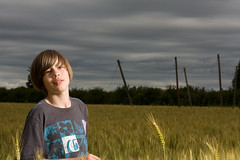
Shutter spd: 1/250
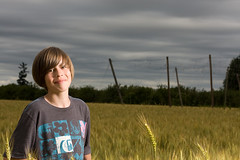
Shutter spd: 1/200
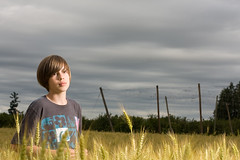
Shutter spd: 1/160th
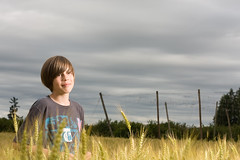
Shutter spd: 1/125th
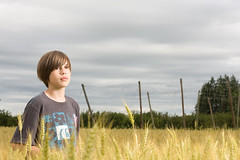
Shutter spd: 1/80th
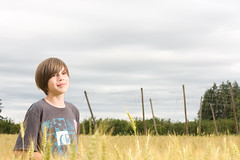
Shutter spd: 1/50th
When we get down to the slower speeds it does start to creep it's way in. And basically what's happening there is that there is SO much ambient (in this case sun-light) light that when I slow down the shutter speed so that it's staying open for 1/50th of a second, more light is getting into the lens and blasted onto the sensor from the sun in that amount of time than from my little Alien Bee light. And the reverse is happening at the opposite end of the spectrum, when it's only open for 1/250th of a second, more light is making it in from the strobe than the sun. When that thing fires it it puts out a whole lotta light in a very short period. Thousandths of a second.
Not only is exposure being compromised at these longer shutter speeds, so is sharpness. The longer the shutter speed the more time that ambient light has to come in and be constantly lighting things that move. Like my nephew. You can see in the second example below that I picked up some motion blur because of the long shutter speed. The first one is at 250th for a point of reference, and the second is at 1/50th. With the strobe blast, as i said earlier, it's such a small fraction of a second that it doesn't matter if he moves.
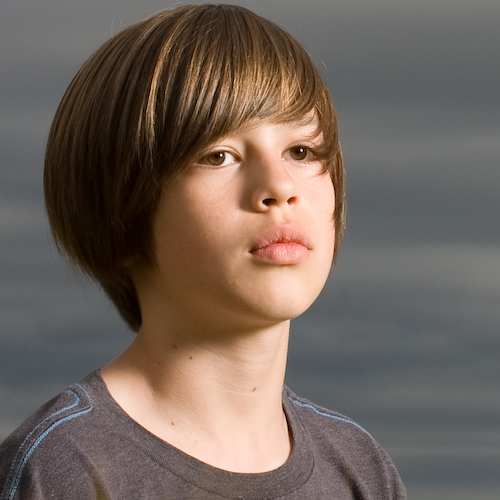
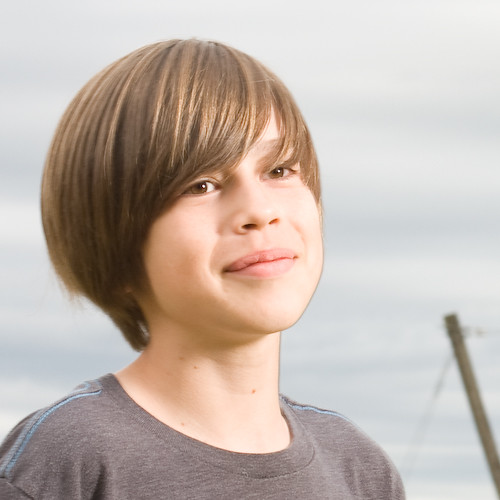
Compare the shadowed side of the face, you can see where in the second image the shadow is filled in by the ambient light. You can also recognize the loss of sharpness from motion blur along the edge of the face and in the hair. It was right after this shot that my light and the 60" shoot through umbrella I was using smashed into the ground. Suck.
Allow me to explain. To my flash, 1/250th of a second feels like an hour. The exposure sequence goes like this:
Shutter opens||||||||||||*flashs fires*||||||||||shutter closes.
*disclaimer* (Yes, there is more going on during this time. Yes there are front and rear curtain considerations and sync and blah blah blah...dont harass me. If you know that stuff, you're wasting your time on my blog right now. I'll get to that, but remember, I said I was starting with the basics.)
Those tick marks represent time that the sensor is being exposed to light. Now, it doesn't know the difference between a flashlight, a headlight, the sun or a glowstick. It just sees light. The longer the shutter speed, the more those tick marks expand out and the greater the effects of the ambient light begin to be.
If we were sitting down having a beer I could explain this to you a million times better. Any questions?

Nick, the main image for this blog post is pristine. Nuff said.
ReplyDeleteMichael (maspauto)
Michael, thanks man. I really appreciate it. It's damn near straight out of the camera. A little contrast bump, cooled down the color temp a smidge, and sharpened a bit, all in Lightroom, and that's it.
ReplyDelete